
MAY CONTAIN NUTS

Search Shorpy
SHORPY ART

Framed or unframed, desk size to sofa size, printed by us in Arizona and Alabama since 2007. Explore now.
Join and Share
Ad-Free Shorpy
Shorpy is funded by you. Patreon contributors get an ad-free experience.
Learn more.

Recent comments
- "Peck turned a sweet propeller"
- National Bank Building
- Notch shot
- Straight ahead (right, left, left, right)
- Ship lifespans
- New service
- You Say Station, I Say Potato ...
- Iron Age
- Thank you, Cornelius Vanderbilt
- Grand Central Terminal
- If they made a movie of it
- Obsolete by then.
- Half the tonnage at the NYPANO dock
- Ravages escaped, bank notes signed and dated
- Chatham expansion
- Steepled in History
- Made by York
- No Summer Vacation
- Wait a minute ...
- $$$
- Joad on the Road
- Street Lights Survive
- Now & then
- More or Less? It's a lot less
- A new image.
- Same ol' story ...
- $13,589,422,507.55 in 2024 dollar$
- Skinned knuckles
- Not enough
- Completed, and then enlarged
Member Photos
The Shorpy
Printporium
Printporium
Search Shorpy
Search results -- 30 results per page
- Chez Heinz: 1936
- January 1936. "Negro house in New Orleans, Louisiana." 8x10 inch nitrate negative by Walker Evans for the ... religion is not something we see in our area. However in New Orleans there is alot of Voodoo practiced. I do not believe that this is ... still has many people living in poverty.
(The Gallery, New Orleans, Walker Evans) ... Posted by Dave - 01/14/2023 - 6:00pm -
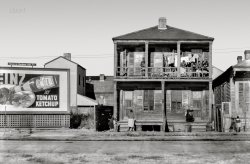
- Royal Castle: 1937
- New Orleans circa 1937. "1300 Royal Street." Longtime residence of A. Fern. ... I've really never felt this before -- what a dump!
The New Orleans Fern Family Likely relatives of the famous Boston branch of this ... four blocks to Frenchmen Street and the best traditional New Orleans Jazz. At the edge of the Marigny, headed down river toward the ... Posted by Dave - 05/22/2014 - 3:42pm -
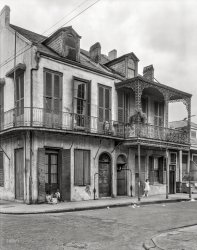
- Sauls Sandwich Shop: 1936
- January 1936. "New Orleans sandwich shop. Orleans Parish, Louisiana." 8x10 inch nitrate ... District, just a few blocks from where I first lived in New Orleans. The area is now covered by one of the onramps to the Crescent ... difficult for a left-hander to emulate.
(The Gallery, New Orleans, Stores & Markets, Walker Evans) ... Posted by Dave - 01/27/2023 - 9:10pm -
![Sauls Sandwich Shop: 1936 January 1936. "New Orleans sandwich shop. Orleans Parish, Louisiana." 8x10 inch nitrate negative by Walker Evans for the U.S. Resettlement Administration. View full size.
I know I'm a dinosaurUnlike kines, I miss cursive and am sad it is no longer taught in schools. For whatever reason it was created, cursive became a very personal part of us. Some have handwriting that is art, some scrawl, but you recognize a person's handwriting the way you will never recognize their printing or texts with emojis. Printing is communication where cursive is conversation. For me, reading letters in cursive is also hearing the writer's voice. Even Sauls' blackboard is a little more inviting than the signage ... that's Sauls talking to you.
EggsWhen I saw the chalkboard I first thought it might be a list of sandwiches. I was hungry. But it's a grocery price list.
Eggs: 25 cents per dozen. That's equal to $5.26 in today's dollars, according to the inflation calculator. Maybe today's "crisis" isn't that bad.
Brands still with usPET [evaporated milk]
Carnation [evaporated milk]
Contadina tomato paste
Luzianne coffee and Tea
Coca-Cola
SignsGood name placement!
Cursed cursiveEven though in my not-so-humble opinion cursive is one of the most inane creations in all of humanity, it is really nice to see it here, adding a distinctly human touch to this otherwise bleak photograph. Said to have been invented to save wear and tear on fragile quill pens, it is now time for cursive to go the way of the carbon arc lamp, typewriter, and the feather quill pen itself.
The original 'saul' food ?I spent my impulse picayunes dining @ N.E. Howe's - or was it N.E Wayze? - but I guess each of us has our own story.
Little circlesAnyone have any idea what those circles on the SANDWICH SHOP letters are?
Long GoneThis is the corner of Prytania and Calliope in the Lower Garden District, just a few blocks from where I first lived in New Orleans. The area is now covered by one of the onramps to the Crescent City Connection bridge over the Mississippi.
Milnut CreamIn 1939 the name was changed to Milnot, a brand that's still around.
Cursive writingis making a sort of comeback, with some schools now starting to teach it again. I agree with Doug Floor Plan that each person's penmanship is an extension of them in some ways. I hope it makes the comeback. Maybe even Spencerian script for some folks. Also, it is just like encryption to some young folks.
Truck ID1928 Ford truck and 1931 Plymouth car
Cursive inclusiveI just want to say, I am fully tolerant and respectful of the opinion of cursive lovers, and I am fully supportive of it being taught as an art form as long as it is not deemed a requirement, or even as being important. And want to share the personal experience that shaped my current opinion. In 8th grade I was doing poorly with cursive and reverted to printing as often as I was allowed. One teacher told me "you might be able to get away with it for now, but you won't be allowed to do this in high school". Then, as if scripted from a movie, my first week in high school I had a teacher tell me how much she loved my printing (which I will also argue is equal to cursive in its recognizability and "extension" of me as a person), and I haven't scrawled a single letter of cursive since. Yet I have had many other compliments on my (non-cursive) penmanship.
Prices Then And NowIn reference to Born Too Late comment: Agree that prices are all relative to the era.
People did not earn $50,000 or $100,000 per year in 1936, as many do now.
Inflation is just an expanding balloon and everything tries to keep up.
Every now and again the balloon goes pop.
Cursive writing styleInteresting comments about cursive script.
I agree with those who say that cursive is an extension of our personality. Each one is different. Some use floral swirls others are more rudimentary and functional. The tightly bound writers reflect a reserved, unimaginative personality, the large bold with swirls attached to many letters would indicate an artistic, creative, open personality.
The manuscripts of earlier centuries contain very impressive examples of script which would have taken a considerable time to write. Japanese calligraphy follows this tradition.
It really is an art form that reflects that we are not machines (yet)
Look at episodes of 'What's My Line' (plenty on Youtube) to see each guest writing their name on a blackboard in beautiful cursive script.
Doctors' cursive is in a world of its own. One might hope that their often undecipherable scrawl (except for pharmacists we assume) is not a reflection of a rushed, chaotic brain.
Cursive is for right-handers onlyCursive is merely artistically stylized sloppy printing where you fail to lift the pen/pencil when you move from letter to letter. It follows the natural movements of a right-handed writer and if rather difficult for a left-hander to emulate.
(The Gallery, New Orleans, Stores & Markets, Walker Evans)](https://www.shorpy.com/files/images/SHORPY-8c52105a.thumbnail.jpg)
- The Graduates: 1927
- ...
Looks like my graduation I went to Ursuline in New Orleans and we wore long white dresses carrying roses.
(The Gallery, ... Posted by Dave - 08/26/2012 - 11:42am -
![The Graduates: 1927 "Class of 1927. Holton-Arms School graduation." Where cut roses compete with coiffed tresses. Harris & Ewing Collection glass negative. View full size.
I'll just be getting my hat...Were the all the pretty girls in a different photo?
The raven!There's a wooden raven or crow in the trellis vines... Top left. What's that about?
SiggyI think I see a young Ridley ... pre-Alien, of course. Find her and she's your date for the prom. If you can handle the challenge.
No longer girlsPresumably these ladies are 17-18 years old but they certainly look a whole lot older than my graduating class (a long time ago) and even my grand-daughter's. Wish I knew why.
Middle ClassOnly one of the girls parts her hair down the middle, and she's the prettiest one.
Guessing gameOk now which ones are really boys in drag?
Some of those girlshave really short legs.
How did Sigourney Weaver get in there?Back row, 4th from left.
SnapshotWhat a strange range of expressions. Was the photographer holding a gun?
Those shoesare exquisite. Real leather top and bottom, no "man-made uppers" for these girls. If I had a time machine, I would go back to 1927 and buy some.
Back row, second from leftHas to be an ancestor of Donald Trump.
HairstylesI'm no fan of the hairstyles from this period but jeez, what kind of style do you call the front row, second from the right?
How charming they all are!And somehow, not one of them is the size of a full grown cow. Why can't young ladies now manage to take the fork out of their mouth? Last I went to the mall the girls had more rolls than a bakery, and plenty of spandex to show it off. In 80 years what will people say about pictures of our gargantuan teens?
Get that thing out of the foreground!I just don't understand why the photographer left that column in the foreground. It's really distracting and there must have been some way to move it or at least use it as a mono pod. I guess I have to give him/her the benefit of the doubt and believe that there was no way around including it.
I've looked at it again, and I think I'd crop it out when printing -- so, in my opinion, there's no excuse for that fuzzy blob of a thing in the foreground!
[The excuse is that this isn't a print. It's the original negative, inverted. - Dave]
Short hairInteresting that by 1927 short hair had become standard and respectable for young ladies. Only one of these girls appears to have long hair (parted in the middle - sort of like the kind at my high school graduation in the 1970s!) I like the quality of seriousness in older pictures by the way. Photographers now are constantly trying to get everyone to smile - sometimes a serious mood is warranted. Graduating from high school is a serious thing!
Makeup!Woof.
Don't Smile"Photographers now are constantly trying to get everyone to smile - sometimes a serious mood is warranted"
Like for Police mug shots.
Those naked bulbsgive just the right unvarnished touch.
Lighten up, girlsI shudder to think of how gloomy the young ladies who failed to graduate must have looked.
So lushIt would have been deliciously painful to see this photograph in full color; we'd have had to have worn eye-condoms or some such. Really, there is some serious blooming going on here -- and I'm not just referring to the trellis, the boxwood hedge or the girls' bouquets; everything and everyone within sight looks as though they're about to explode -- in a reserved and self-controlled way, of course. Lovely, lovely photo -- and what a perfect prelude to one of the loveliest months of the year -- May.
Who? Him?'Tis some visitor entreating entrance at my chamber door.
I hope, I hope, I hope...I haven't torn the knees out of these silk stockings...Mom will kill me....darn photographers!
(I will take Miss 2nd from right, front row left)
Most of those girlshave gone to the same hairdresser, and look way too old to be graduating high school. Some look like they could have been somebody's mother a few times over. Way too severe, but that was the times I guess we could say.
YupYou've got seven young ladies with "short legs" and one young lady with a short skirt. They go well with all the short hair. I trust that, shortly, they all went on to live illustrious lives, hopefully not short in duration.
Why is no one smiling?I notice in a lot of these pictures celebrating special occasions that the mood is very serene. Although you can clearly see the joy in the eyes a few of the ladies. Top row, 3rd from left and 5th from left are clearly subduing a grin. Lovely photograph all the same!
DignityThat's what's present in this picture and lacking at most modern high school graduations.
100 years oldIt never ceases to amaze me, looking at these lovely fresh young faces, graduating from high school. If any of them are still alive, they'd be 100 years old now. I know a woman who is soon to be 97, so she'd be a freshman when this was taken, and she's so very very old. Just wow.
Susan Boyle?The girls look older because we associate this look with women we knew from that era, who were, obviously, old. They also appear unattractive to us because we have become so inured to makeup, which can do a lot to make an average girl look like a pretty girl. Also, eyebrow management? They weren't into it.
BulbsI wonder how they held up in the rain.
Tidal WaveMost of these hair styles are marceled -- deep waves set by hot curling tongs. Miss Second-From-Right-In-Front is sporting what would probably be called a Tsunami today.
Beautiful graduations still exist!My niece attended Meredith College, an all girls school in Raleigh NC where traditions are held quite dear. Their graduation service, held on Mother's Day, reminds me of the graduation photo shown here. The sophmore girls are "little sisters" to the seniors. They wear white dresses & carry thick long greenery garlands intertwined with flowers & sing as they walk down two sets of steps outdoors at an amphitheater that faces a lake. They circle the center of the amphitheater & spell out the graduating class year with the flower garland. It is really lovely - sweet & sentimental.
Amazing shoes...Great shoes. Great dresses. The bobbed hair, some with waves (weren't they called marcel waves?) must have been the hot thing.
I Spy the flapper!The girl in middle section, 2nd from right, has her hair bobbed, and has a much more current dress than the other girls. Her shoes are a different leather too. She's clearly making a big splash with her tantalizingly short skirt and cascading hemlines. I wonder if the other girls envied her freedom and if after graduation they all ran out to get their flapper kit together?
I visited Holton-Arms once about 25 years ago. It seemed to be filled with mean girls and really a really harsh head of school.
Retro-RetroIt's fun to see how styles of one era influence another. The girl in the back row, second from left, could be a sister of Twiggy or Judy Carne.
Looks like my graduationI went to Ursuline in New Orleans and we wore long white dresses carrying roses.
(The Gallery, Harris + Ewing, Portraits)](https://www.shorpy.com/files/images/20846a.thumbnail.jpg)
- Retail White House: 1910
- New Orleans circa 1910. "Maison Blanche, Canal Street." 8x10 inch dry plate ... Detroit Publishing Company. View full size.
New Orleans - Signs of Light? Just wondering: what is that grid above the ... in the city, into the early 1990s. -- Infrogmation of New Orleans
This is the 2nd Home of Maison Blanche This is the second ... Posted by Dave - 07/26/2016 - 3:33pm -
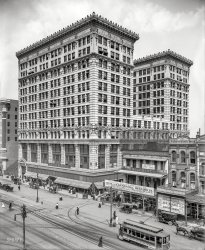
- Audubon Building: 1910
- New Orleans circa 1910. "Audubon Building, Canal and Burgundy Sts." This former ... Both the Audubon Building and the Audubon Hotel in New Orleans changed their names within the past decade: the building to the ... Plus he shot all those birds before he painted them.
New Orleans balconies I love those ornate cast iron 'galleries.' That type ... Posted by Dave - 08/26/2021 - 9:23am -
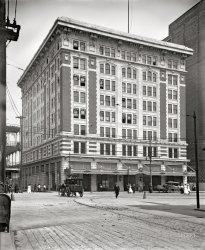
- On the Mend: 1900
- ... So far I've been able to make out the U.S.S. Newport, the New Orleans (front row seated rt. of center), and the Yankee (second row far ... - Dave]
The Newport was a gunboat, the New Orleans was a cruiser, the Yankee was an auxiliary cruiser.
50 ... Posted by Dave - 08/14/2012 - 11:13am -
![On the Mend: 1900 New York circa 1900. "Group of patients, Brooklyn Navy Yard hospital." 8x10 inch dry plate glass negative, Detroit Publishing Company. View full size.
The Dry LookNot any greased-up or plastered down hair in this group. The hair styles look very close to what most men are wearing today.
New York ObserverFellow in white at the top of the stairs.
Represented vesselsSo far I've been able to make out the U.S.S. Newport, the New Orleans (front row seated rt. of center), and the Yankee (second row far right) and what I think is the Cincinnati (back row center). Front row seated third from left and second row fourth from right are sailors on which ships?
[U.S.S. Vesuvius. - Dave]
The Newport was a gunboat, the New Orleans was a cruiser, the Yankee was an auxiliary cruiser.
50 years before my time butThe blue uniforms are about the same with piping and 13 button pants. Several are probably boatswain mates because of their pipe lanyards. One may be a marine and another an officer. The guy in blue on the right gets the respect of everybody. And a couple may have have been in the Civil War.
YensI suddenly have an overwhelming craving for Crackerjack.
SpookedI was in the Brooklyn Navy Yard about 10 years ago as a software rep servicing a client. The place was a vast ghost town of many different and unusual decaying buildings, and apparently a haven for crime. They wouldn't let me walk around alone and I had to check my car from the window every hour or so. Some of the remaining buildings that were in passable shape were being used for small businesses. If the walls could talk that place would still have my ear.
Looks like a ventriloquiston the right side of the photo!
House DetectiveDarkman lurking under stairwell.
Comic ReliefCheck out the ventriloquist act on the right.
See also: Sick Bay 1900We saw at least a couple of these guys here. In particular, you can't miss the guy with the bandage around his head.
13 Button TrousersLooks like these guys were no more fastidious about doing up all the buttons than I was when I used to wear them. The ships USS New Orleans and USS Newport were involved in the recent conflict with Spain.
Big Bluejacket on the rightThere was a guy on my ship who looked a lot like him. We called him the Abominable Seaman.
Pasted In?It looks like the face of the young man in the white jacket, center second row, has been physically pasted in, note the distinct ring around the head.
[That's a bandage. Next question! - Dave]
Uniform VariationThe wide variety of uniforms and uniform items is notable. The three stripes at the end of the sleeve denote seaman first class, two denote second class. The shoulder watch mark on the seated SN - fifth from left in whites - reveals that he is assigned to the port watch.
Those lanyards may be knife lanyards.
Early versions of the dixie cup cover sometimes lacked sufficient stitching to stay in place - hence the floppy appearance.
Cuff PipingThree rows of piping was standardized on the blue collar in 1876..
Cuff piping was used to identify rank until 1947. Three rows identified Petty Officers, along with their "Crow"
Guy far rightis sitting on the next guy's knee!
It's a real wonderHow they kept those flatboard hats on their heads! Checkout the guy in the center, that a real "old salt."
Where is swee'pea?I yam what I yam, and that's all I yam.
The HulkThe fellow standing on the far right looks like someone no one would want to mess with.
Represented VesselsU.S.S. Vesuvius was a dynamite cruiser, a not very successful experiment.
(The Gallery, DPC, Medicine, NYC)](https://www.shorpy.com/files/images/4a14990a.thumbnail.jpg)
- New Orleans: 1964
- ... Jeffrey again; this time in front of the Café Du Monde in New Orleans; probably taken in 1964. We'd drive over from Houma, where we then lived, and spend the weekends. The New Orleans farmer's market was a fun place to visit in those days; we'd go ... Posted by Jim Page - 10/05/2012 - 8:45pm -

- Absinthe and Bourbon: 1903
- New Orleans circa 1903. "Old Absinthe House and Bourbon Street." (*Hic*) 8x10 ...
Old Absinthe House
Since 1807
240 Bourbon Street
New Orleans
Drink Up Before It's Gone A peek inside at Absinthe ... 1906 .
Motor Age, November 9, 1916.
New Orleans — America's Paris
The Old Absinthe House is one of ... Posted by Dave - 11/12/2012 - 3:42pm -
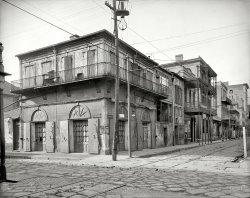
- Cotton Club: 1900
- Circa 1900. "Cotton Exchange, New Orleans." Something of a boll market. 8x10 inch dry plate glass negative, ... the picture, where do you water your animal in hot, humid New Orleans?
[At a horse fountain . - Dave]
Groaner " Boll ... Old Cotton Exchange are on City Park Avenue in Mid-City New Orleans.
Second Empire "The Exchange had its 1871 opening in a ... Posted by Dave - 07/19/2012 - 4:39pm -
![Cotton Club: 1900 Circa 1900. "Cotton Exchange, New Orleans." Something of a boll market. 8x10 inch dry plate glass negative, Detroit Publishing Company. View full size.
Hard Rock!Those are some serious cobblestones on those streets!
InfrastructureThis photo would seem to illustrate a complex, unstandardized infrastructure at the turn of the last century. Note the different manhole covers, and the lengthy steel plating that appears as a sidewalk on both sides of the street - providing access to what? Cobblestone streets and trolley tracks.
The telephone/power poles with their myriad of lines - that I never see entering any of the buildings. Only one of the poles seems to use footspikes.
Are those trash containers on the sidewalks with the narrow slit openings?
Although there appear to be hitching posts in the picture, where do you water your animal in hot, humid New Orleans?
[At a horse fountain. - Dave]
Groaner"Boll market."
Dave, go to your room.
Top of the rightmost buildingI love the fancy Victorian buildings, but what caught my eye was the framing at the top of the building to the right of the Cotton Exchange. Do you suppose there's more building to come there, or maybe the top story burnt and wasn't rebuilt (apparently pretty common, based on the history of other buildings I've read.)
[Those cornices were most likely decor (or marquee supports) for one of the "roof garden" restaurants popular at the turn of the century. - Dave]
GaudyThat is the first word that comes to mind when looking at this building. Excessive and overblown are the other two. the ornamentation is WAY out of proportion to the rest of the building. I love it.
Also a great image of the carbon arc light there on the left.
King Cotton in ExileThis was the Cotton Exchange Building constructed in 1871, and replaced in 1920 by the building still here today (although it now houses a hotel).
When they demolished the old building, a few architectural details were salvaged. These Caryatides from the Old Cotton Exchange are on City Park Avenue in Mid-City New Orleans.
Second Empire"The Exchange had its 1871 opening in a series of rented rooms in an existing building at Gravier and Carondelet. Although they moved several times, the Exchange would not leave this intersection until its closing in 1964. After constructing and then outgrowing a small building nearby on Gravier, the Exchange built a palatial Second Empire building in 1883 at the northern corner of Gravier and Carondelet, designed by architect S.S. Labouisse. Noted for its lavish interiors, the building soon became a landmark in New Orleans."
http://www.absoluteastronomy.com/topics/New_Orleans_Cotton_Exchange
The Original Hooters?Judging by the statuary, they served hot wings in this Cotton Club.
Extravagant OrnamentThe elaborate decoration on the original Cotton Exchange is a testament to the amount of money being made in the cotton industry. The building was at the corner of Gravier and Carondelet and was built in 1883. It was demolished and rebuilt in 1921 in the Renaissance Revival style. The replacement was listed on the National Register of Historic Places in 1977.
The only building from the photo that still remains is the one at the far right - currently home to Hancock Bank. It's interesting that the floor above the cornice has since been built out.
Men, men, men.The only women I spot are of the stone variety.
SprainedJust one look at that cobblestone street and I got a broken ankle. Ladies with stilettos keep your distance.
Agriculture, Industry & Peace
Life on the Mississippi, 1883.
Mark Twain.
Not that there is any 'architecture' in Canal Street: to speak in broad, general terms, there is no architecture in New Orleans, except in the cemeteries. It seems a strange thing to say of a wealthy, farseeing, and energetic city of a quarter of a million inhabitants, but it is true. There is a huge granite U. S. Custom-house — costly enough, genuine enough, but as a decoration it is inferior to a gasometer. It looks like a state prison. But it was built before the war. Architecture in America may be said to have been born since the war. New Orleans, I believe, has had the good luck — and in a sense the bad luck — to have had no great fire in late years. It must be so. If the opposite had been the case, I think one would be able to tell the 'burnt district' by the radical improvement in its architecture over the old forms. One can do this in Boston and Chicago. The 'burnt district' of Boston was commonplace before the fire; but now there is no commercial district in any city in the world that can surpass it — or perhaps even rival it — in beauty, elegance, and tastefulness.
However, New Orleans has begun — just this moment, as one may say. When completed, the new Cotton Exchange will be a stately and beautiful building; massive, substantial, full of architectural graces; no shams or false pretences or uglinesses about it anywhere. To the city, it will be worth many times its cost, for it will breed its species. What has been lacking hitherto, was a model to build toward; something to educate eye and taste; a suggester, so to speak.
The Picayune's Guide to New Orleans, 1903.
At the corner of Gravier and Carondelet stands the Cotton Exchange, which is a fine specimen of the Renaissance style of architecture, and is considered very beautiful. It is built of cream-colored stone. The cost of erection was $380,000. The Cotton Exchange was organized in 1871, with a membership of 100. It has now almost 500 names on its roll. The Exchange proper occupies a beautiful apartment superbly frescoed with scenes from the history of Louisiana. Futures are sold around the small fountain at one end of the room. The Exchange enforces obedience to its rules for sampling, buying, selling and delivering cotton, and settles all disputes by arbitration. Reports of the receipts of cotton at all ports, exports and imports, meteorological and crop reports, and other indispensable information are daily posted on the blackboards. The upper floors of the building are occupied by business offices. A small gallery, accessible from the stairway or elevator, is open to visitors. A fine view is obtainable from the roof of the building. There is a time-ball on the roof, regulated by telegraphic communication with Washington. It is dropped daily at noon. The Bureau of State Engineers, where the engineering work of the Louisiana Levee system is done, is located in this building.
New Orleans in the Twenties, 1993.
Mary Lou Widmer.
The Cotton Exchange Building, at the corner of Gravier and Carondelet, built in 1882-83, was ready for the wrecker in 1920. Five statues adorned the building, three on the third floor representing Agriculture, Industry and Peace and two on the ground floor as column supports called caryatids. The statues were moved to City Park in the 1920s for a brief stay. The caryatids now stand in the 100 block of City Park Avenue.
Below: 1919 photo of the Peace statue of the Cotton Exchange building, taken during demolition. Also note the reclining caryatid. [source: Louisiana Digital Library.]
Does it open at 8?The clock appears to say 7:34. I'm guessing it's morning and the loafers near the door are waiting for the Exchange to open.
Re: Infrastructure>> The telephone/power poles with their myriad of lines - that I never see entering any of the buildings.
How about these? Admittedly scary, though.
"Cotton Exchange""Boll Market" -- that's funny, right there!
Carved or PouredI was wondering if the repetitive ornamental work on these old buildings was made from pouring concrete in a mold or would they have been individually carved from sandstone or some other material?
Cobblestones and steel platesThe large paving blocks were called Russ blocks after the inventor. Most of the city streets were paved this way from the 1850s through the 1880s. They were layed at a 45 degree angle to prevent wagon wheels from eroding the joints and getting stuck. Unfortunately, Russ blocks were a disaster as the joints were spaced farther apart than the size of a horse's hoof. When the blocks weathered the tops became rounded with deep crevices in between (have a look at the well-used paving stones in the old French Market photos to get an idea). When wet, horses often slipped, fell and broke legs. Russ blocks were gradually replaced by the smaller "Belgian" blocks by the 1890s. Neither of these paving types were "cobblestones" which refers to uncut smaller rounded stream cobbles that were used earlier. You can still find old Russ blocks recycled for private walks in the city. Just last year, the last street of exposed Russ blocks (Montegut street riverside of Chartres in the 9th Ward) was unnecessarily ripped up by an apartment developer. They relayed the blocks at 90 degrees with lousy wide joints. Undoubtedly, the 150 year old pavement with morterless hand-fitted seams would have remained serviceable longer than the current, historically inaccurate scheme. There are still some Russ blocks hidden under the modern asphalt.
As for the iron or steel plates, these were used throughout the business districts to bridge and cover the deep curbside drainage ditches. Interestingly you can see many of these being used to bridge curbside ditches at modern driveways uptown; they still have the names of dowtown streets on them.
(The Gallery, DPC, New Orleans)](https://www.shorpy.com/files/images/4a04318a.thumbnail.jpg)
- New Orleans Police Band
- New Orleans Police Department Band in front of the Carnegie branch library ... for posting this photo. I found it just doing a search of "New Orleans Police Band."
(ShorpyBlog, Member Gallery, Music) ... Posted by Infrogmation - 09/20/2011 - 9:20pm -
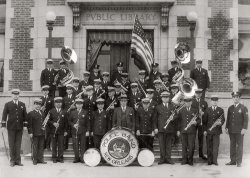
- Haunted Saloon: 1906
- New Orleans circa 1906. "Haunted House (Warrington House), Royal and Hospital ... You can read the history of the building here .
New Orleans Such wonderful memories! Grandparents lived in Belle Chase; ... Telephone in 1900, becoming the only phone company in New Orleans. They advertised rates as low as $1 a month for homes and $2 for ... Posted by Dave - 11/17/2017 - 2:35pm -
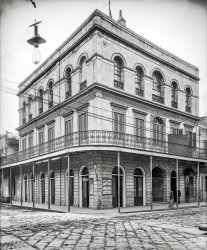
- Lafayette Square, New Orleans
- John McDonogh Statue in Lafayette Square, New Orleans, Louisiana, created by Hyram Powers and donated by school children of New Orleans from 1892-1898.
Found in an attic, M. A. Seeds (Seed Dry Plate ... Posted by Christoph Traugott - 03/17/2017 - 6:31pm -
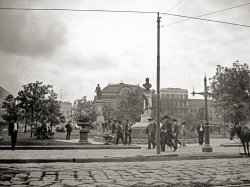
- Bread and Water: 1906
- ... grain from floating elevator." Continuing our visit to the New Orleans waterfront circa 1906. 8x10 inch glass negative. View full size.
New Orleans? Hmmm. No levy but there should be. There isn't much to go by ... Posted by Dave - 08/14/2012 - 3:37pm -
![Bread and Water: 1906 "Steamer loading grain from floating elevator." Continuing our visit to the New Orleans waterfront circa 1906. 8x10 inch glass negative. View full size.
New Orleans?Hmmm. No levy but there should be. There isn't much to go by here but looks more Savannah to me. The "elevator" is transferring grain from No. 67 to the steamship.
[The "levy" (levee) would be in the vicinity of the telegraph poles, the same ones seen here. - Dave]
Convenient Grain
Engineers and Engineering, Engineers Club of Philadelphia, 1922.
Grain Handling
When grain forms only a small portion of the cargo, grain is put aboard by the use of floating elevators brought to them in grain barges, while other miscellaneous merchandise is being loaded at a freight pier. This saves the time and expense, which would be required to move the vessel from the freight pier to the grain elevator to take on the balance of the cargo.
The vessel being loadedis the Traveller, owned by Charente Steamship Company of London. Launched June 22, 1888 at Scotstoun, outside Glasgow, by Charles Connell & Co. Sold in 1919 to the Limerick Steamship Co. of Ireland, and renamed Inishboffin, it wrecked on Wulff Island, Gulf of Finland, on December 13, 1921. Refloated the following May, the vessel was broken up at Hamburg in 1923.
(The Gallery, Boats & Bridges, DPC, New Orleans)](https://www.shorpy.com/files/images/4a10818a.thumbnail.jpg)
- Luncheonette: 1950
- ... a surprise to find that it was still 5 cents on a visit to New Orleans in 1976.
Delightful memories Not only do I want to buy those ... Posted by sledworks - 11/13/2011 - 6:16pm -
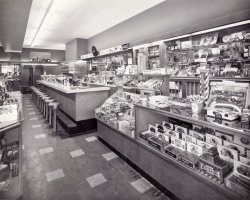
- Parking In New Orleans: 1965
- ... Fats Domino song? Here is a second image from the trip to New Orleans; this time up the street from the Café Du Monde near the levee. New Orleans residents can correct me here, but wouldn't this be about in front ... Posted by Jim Page - 10/12/2012 - 8:26pm -
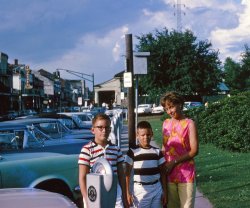
- New Orleans Bride: 1888
- ... a photographer's studio near the Old French Opera House in New Orleans. I am not at home with the pic and I forgot to scan the back, so I ... Posted by catsoldpics73 - 06/28/2011 - 11:02am -

- Steeling Home: 1941
- ... the buses still run out to Aliquippa.
14 years later, New Orleans Inevitably reminds me of Robert Frank's 1955 photo of a New Orleans trolley. In choice of subject and framing, Delano and Frank evoke ... Posted by Dave - 04/04/2022 - 5:30pm -
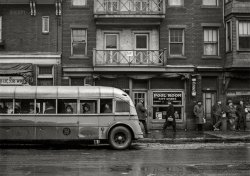
- The Dog-House: 1940
- 1940. "New Orleans, Louisiana. Old building at Rampart and Bienville streets." Medium ... else about him tells me he can take you places in New Orleans that are not included in the Chamber of Commerce list of local ... driver" was MPW. - Dave]
From the 1938 WPA Guide to New Orleans Dog House, 300 North Rampart St., is open from 9 P.M. until 4 ... Posted by Dave - 09/23/2019 - 6:32pm -
![The Dog-House: 1940 1940. "New Orleans, Louisiana. Old building at Rampart and Bienville streets." Medium format acetate negative by Marion Post Wolcott for the Farm Security Administration. View full size.
Don't bother looking on Google street viewOne modern building and three parking lots
:-(
Take me somewhere special, driverThe cap pushed jauntily back on his head tells me the guy in the white shirt leaning against the corner is the driver of the Checker Cab at left. Everything else about him tells me he can take you places in New Orleans that are not included in the Chamber of Commerce list of local attractions.
Oh, that Marion Post Wolcott asked to go photograph such a place. Not for the smut, but for the depth she brought to her subjects.
[MPW didn't "ask to go" photograph this place. - Dave]
Sorry, I should have said: Oh, that Marion Post Wolcott had asked the driver to take her to such a place. Not for the smut or the violence, but for the depth she brought to her subjects.
["The driver" was MPW. - Dave]
From the 1938 WPA Guide to New OrleansDog House, 300 North Rampart St., is open from 9 P.M. until 4 A.M.
Both jazz orchestra and floor show are colored, and three performances are given nightly, 11 P.M., 1.30 and 3 A.M. A high-class place, says the proprietor, for middle class people, and one where they can have freedom of body and soul. The taxi girls bring their lunch.
Can't be 1940With that at least 1942 Chevrolet, already rough around the edges, lurking there on the left.
[The car is a 1941 Chevrolet, introduced in 1940; both cars have 1940 plates. - Dave]
Big Yellow TaxiDon't it always seem to go
That you don't know what you've got til its gone
They paved paradise
And put up a parking lot
A floor show at 3:30 AM? Wow. As a habitue of bars in my youth I remember bars and their customers at the usual closing time of 2 AM but 3:30 AM customers watching a floor show must have been a thing of beauty to behold to a people watcher and a pub crawler like me.
According to google View there are 3 parking lots at this corner so I'm going with the hope I called the shot of a parking lot where the Dog House stood.
(The Gallery, Eateries & Bars, M.P. Wolcott)](https://www.shorpy.com/files/images/SHORPY-8c14682a.thumbnail.jpg)
- Port of New Orleans
- ... detailed: Lafayette Square and Metairie Cemetery in New Orleans, Port of New Orleans, and family farmhouse locations nearby New Orleans. View full ... Posted by Christoph Traugott - 02/24/2017 - 8:22pm -

- The Sultan's Palace: 1937
- New Orleans, 1937. "Le Pretre Mansion, 716 Dauphine Street, built 1835-6. ... size.
Iron Lace There is nothing more iconically New Orleans than lacy ironwork balconies and long shuttered windows. I'm so in ... still exists? I'm from Oregon, but I've always loved New Orleans and will be back soon to visit. I'd love to put this gem on my ... Posted by Dave - 08/03/2012 - 4:05pm -
![The Sultan's Palace: 1937 New Orleans, 1937. "Le Pretre Mansion, 716 Dauphine Street, built 1835-6. Joseph Saba house. Also called House of the Turk." As well as the Sultan's Palace. 8x10 inch acetate negative by Frances Benjamin Johnston. View full size.
Iron LaceThere is nothing more iconically New Orleans than lacy ironwork balconies and long shuttered windows. I'm so in love with this image!
Does anyone know if this building still exists? I'm from Oregon, but I've always loved New Orleans and will be back soon to visit. I'd love to put this gem on my list of places to see if it's there!
One last question - is it because of potential flooding that the home appears to be built one story above the street entry level? Do those lower floors get used at all, or are they essentially a basement?
IntoxicatingAnyone who has spent time in New Orleans knows there is no other place quite like it. It creates an atmosphere that is almost mind-altering, with the close, sultry, earthy air (no air conditioning in those days) and the curious, intimate stillness that occasionally occurs as in this photo, streets deserted with no signs of life except a bit of trash lying in the gutter. Where is everybody? They are inside and there lies the inspiration for the imagination. Especially intriguing are the rooms behind the real, fully functional shutters, open to air, closed to rain. Are the people within just trying to stay cool with overhead fans, are they cooking spicy, savory red beans and rice, are they making crazy love, sipping sweet tea and sampling pralines, listening to Louis Armstrong on the Victrola? I am transported back there by this so-accurate portrayal of a New Orleans street to where I can smell the smells and feel the surrounding humanity close, but unseen. Thank you Shorpy. As we know, you can leave New Orleans but New Orleans NEVER leaves you.
Nice words, OTYYou've captured so beautifully what makes New Orleans unique. It is one of the world's great cities "with a feel" that you just can't and won't find anywhere else. I've been there half a dozen times or so, and every time I visit that curious intimate stillness you speak of strikes me.
Harem of HorrorI've spent many a night in this house but I never heard the thump of heads of the Sultan's harem rolling down the stairs ... just the thump of tipsy neighbors falling up the stairs!
http://www.nola.com/haunted/harem/hauntings/murder.html
http://www.neworleansghosts.com/haunted_new_orleans.htm
["The Sultan's Massacre" makes a good ghost story, although it doesn't seem to be anything more than that -- a story. Any actual massacre would have been recorded in the newspapers of the day, and the "sultan" would have a name. If I had to pin one on him I'd say it was the Muslim entrepreneur Joseph Saba, who bought 716 Dauphine, along with several other New Orleans properties, after coming to America from Syria in 1886. What with Syria being part of the Ottoman Empire at the time, he could have been considered Turkish, although he wasn't a sultan, and seems to have died of natural causes. - Dave]
The beauty of cast ironNow that large buildings are made of glass and steel, we see what we have lost: romance.
Desiring a streetcarIts a shame that they tore out almost all of the streetcar system, the local traffic from Bywater to Carrollton and everywhere in between is miserable and could be seriously helped by better transit than the buses.
Thank goodness for Google maps!This wonderful building still stands at the corner of Dauphine and Orleans Streets. It looks like most of the incredible ironwork is still there, as are the original shutters (some missing a few slats).
The trolley car tracks are long gone, torn up and asphalted over, as happened in so many American cities in the decades between 1930 and 1950.
Does the personal-injury lawyer who occupies the building know its history and alias? Let's hope a friend sends her to Shorpy if she doesn't.
View Larger Map
Thanks, Dave, for adding the map link. Shorpy has made a reflex out of the use of Google maps for street-level architectural site obit checking.
Yes. The building is still there.This one, in particular has a good ghost story about it. A deposed Sultan rented the place and fillled it with harem girls and armed guards, not participating in the regular Creole culture of the City at all. Every single person in the building was found butchered to death one night. The people were chopped into little bits and the police couldn't tell how many people were killed. So the place is haunted. "They" say that it was his brother, the real Sultan who had the entourage killed, the murderers escaped before the crime was known to the public.
I went to a garage sale in the courtyard once and pass by the building all the time. I just love living here in the Quarter.
Many homes are elevated or have storage type basements that are actually sitting on ground floor.
Re: Iron LaceThe French Quarter is on the highest ground in New Orleans, and since the installation of pumps in the 1890s, flooding, beyond an inch or so in the street, has been a rare event. The lower floors of all buildings in the Quarter are functional. True, subgrade basements are very rare in New Orleans.
Dauphine dreamI was a bellman at a bed and breakfast on Dauphine Street my freshman year at Tulane in 1985. I had to be at work at 7 am Saturday and Sunday. I rode my bike from uptown, and this picture really reminds me of the early morning stillness of the Quarter.
IronworkMuch of the intricate and beautiful wrought iron that has helped make New Orleans so unique was actually made in the industrial North, mostly Cincinnati. Then it was floated down the Ohio River to the Mississippi River and onto the balconies and steps and whatnot in N.O.
(The Gallery, F.B. Johnston, New Orleans)](https://www.shorpy.com/files/images/01251u.thumbnail.jpg)
- The Wild Bunch: 1905
- ... by 1960.
Same scene in 1954 February 1954 at New Orleans, our Navy destroyer tied up next to an unloading banana boat where ... Posted by Dave - 08/02/2012 - 4:15pm -
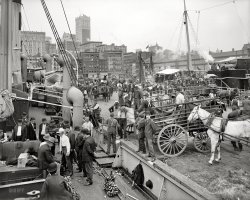
- Leviathan: 1926
- ... Crescent" - that refers to the Cincinnati - Chattanooga - New Orleans route, and was applied to no. 6689) and assigned to the new, ... Posted by Dave - 07/17/2012 - 10:13pm -
![Leviathan: 1926 Washington, D.C., or vicinity circa 1926. "Southern R.R. Co. Crescent Locomotive 1396." View full size. National Photo Company Collection glass negative.
Queen Crescent LimitedA short history of the Queen Crescent Limited.
1396, 1926
Still puffin'I have lived in Chattanooga and more than once rode on the excursion trains pulled by this locomotive! (see history link)
I must compliment Dave on the enlargements of small details in the photos. Reminds me of the movie "Call Northside 777" in which the murderer is caught because the photo lab enlarges the date printed on a newspaper held by a newsboy! Ever tried newspapers, Dave?
[Yes indeedy. - Dave]
One of your best yet.This is one of your best yet. Very handsome.
Cheers to you and the National Photo Company.
Southern ClassA Great Railway. Great class of loco: Ps4. Same as the one in the Smithsonian. WOW!!
ExcursionsAs far as excursions, you're probably thinking of Southern Ry. #4501, a freight engine, which was bought back from a shortline, and painted-and-otherwise-gussied-up to represent a passenger engine. It pulled many excursions starting in 1966. The real SR passenger steamers didn't make it past 1953 or so. (When the management realized steam excursions would be a real crowd-pleaser, the one in the Smithsonian was already "trapped inside.")
WowBravo.
Old 1396Beautiful engine absolutely beautiful! She was built 9 years & 9 months before I came along. Reminds me of the troop trains in the 1940s, heading south on the L&N Line as they passed through my hometown in central Kentucky, a little burg called Wildie in Rockcastle County. Wish I was back there now.
Greatest achievementI maintain that the steam locomotive remains mankind's greatest accomplishment.
WOWThis photo was taken in Southern Railway's yard in Alexandria, near the King Street station - if you look just to the right of the most distant power pole, you can see the George Washington Masonic Temple.
No. 1396 was one of the first 12 PS4s delivered in Southern Railway's new "Sylvan Green" paint scheme. Most were lettered "Southern" on the tender, but no. 1396 was lettered "Crescent Limited" (not "Queen & Crescent" - that refers to the Cincinnati - Chattanooga - New Orleans route, and was applied to no. 6689) and assigned to the new, all-Pullman luxury train of the same name.
Alexandria YardThe George Washington National Masonic Memorial was dedicated in 1923 but not mostly completed until 1932, so I don't believe that appears adjacent to the far telegraph pole. I believe this view is looking roughly east, with the wooden yard office to the right of the locomotive. About where the boxcars are out of view in the distance is where Hoofe's Run crossed under the tracks.
-- Frank R. Scheer, Railway Mail Service Library
Museum PieceThe same class of locomotive photographed by me in 2006 when I visited the Smithsonian's railroad section.
My favoriteThis is my favorite of the images posted on Shorpy this past year. I don't know why; I'm not interested in railroads or big machines. I keep coming back to it, though. Perhaps it's because despite my disinterest I admire this magnificent machine and the work that went into creating and maintaining it. It makes me think about traveling and I imagine how people of the time would have looked at it in awe and thought of the big cities and world beyond their own region.
Thanks Dave and crew for the work you've done and thanks to all the insightful Shorpy posters. Best wishes for the new year, and many more intriguing photos and enlightening posts.
Looking east toward Callahan StreetThis view of the Southern Railway yard in Alexandria is looking east. The Masonic Temple would be behind the photographer's left shoulder. The little yard shacks were on the other side of Callahan Street. These shacks were there as late as 1980 or so as I have a photo of them. The roundhouse was to the right of the locomotive, probably out of the picture. The building to the right may be the yard office. The Northern Virginia Model RR club occupied a building in this approximate location for about 20 years from the early '50s until the early '70s.
Herby's Ford was located to the left of the photo, on the opposite side of the Callahan Street crossing. It was built soon after WW2.
Leviathan in colorSadly there are no contemporary color images of Ps-4s in their early days, but my friend Tom Alderman of Mayretta, GA has given us an idea of what it looked like on that day in Alexandria when 1396 posed for the camera.
(The Gallery, Natl Photo, Railroads)](https://www.shorpy.com/files/images/32810u1.thumbnail.jpg)
- The Big Easy: 1935
- October 1935. "Scene in Jackson Square, New Orleans." 35mm nitrate negative by Ben Shahn for the Farm Security ... guess she is single.
Ma and Pa Kettle do New Orleans.
(The Gallery, Ben Shahn, New Orleans) ... Posted by Dave - 09/13/2011 - 4:40pm -
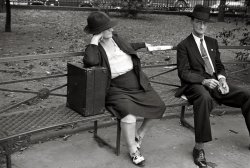
- The Rookery: 1938
- ... look after one.
Fast Forward to... some areas in New Orleans, post Katrina, and there's not much difference!
Looks like an ... isn't falling down, go to Laura Plantation , outside New Orleans.
Trees and Hurricanes The records indicate a hurricane based ... Posted by Dave - 08/30/2012 - 11:03am -
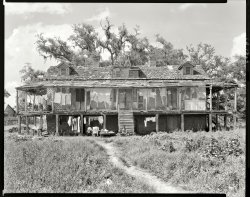
- Price, Birch & Company: 1865
- ... half the coastal slave trade from Virginia and Maryland to New Orleans. In 1846 the property was sold to a Franklin and Armfield agent, ... dealership Northrup went through in 1841 on his was to New Orleans. At the time, Alexandria City and Alexandria County were still ... Posted by Dave - 07/31/2012 - 7:26pm -
![Price, Birch & Company: 1865 Union Army guard at Price, Birch & Co. slave pen at Alexandria, Virginia, circa 1865. Detail of albumen print. View full size. Photograph by Andrew J. Russell.
still more infoI accidentally left the address off of that last comment. It's listed as "1315 Duke Street"
Here is the location in google maps. This is only a few miles from where I currently live. Perhaps I'll try to get down there this weekend and shoot some shots of the front of the building as it appears now. If so, I'll post a note and link here.
-gary
[Thanks Gary. Here's a satellite view of the address. - Dave]
more infoMore info, via:
http://oha.alexandriava.gov/oha-main/oha-natl-register.html
Franklin and Armfield Office
Click to enlarge
Built in 1812 as a residence for General Andrew Young, this was the office building of the former interstate slave trading complex which stood on the site from 1828 to 1861. By 1835 Franklin and Armfield controlled nearly half the coastal slave trade from Virginia and Maryland to New Orleans. In 1846 the property was sold to a Franklin and Armfield agent, George Kephart, whose business became "the chief slave-dealing firm in [Virginia] and perhaps anywhere along the border between the Free and Slave States." After 1858, the slave pen was known as Price, Birch, and Co., and their sign can be seen in a Civil War era photograph. The business was appalling to many, especially to active abolitionists in Alexandria, where the large Quaker population contributed to a general distaste for slavery. Several abolitionists' accounts survive which describe the slave pen and the conditions encountered therein. Behind the house was a yard containing several structures, surrounded by a high, whitewashed brick wall. Male slaves were located in a yard to the west, while women and children were kept in a yard to the east, separated by a passage and a strong grated door of iron. The complex served as a Civil War prison from 1861 to 1865, and housed the Alexandria Hospital from 1878 to 1885. It was later apartments, and was renovated as offices in 1984.
source?The slave pen series is fascinating. Have you any idea who took the photos, and why? And, what are the half-barrel-like things lying on their sides in the last image?
Slave pen photosThe exterior view is by Andrew J. Russell, who has hundreds of Civil War era photographs in the Library of Congress archives. The interior shots, each half of a stereograph pair, are unattributed but might have been taken by him also. The things on the floor look like watering troughs for horses and may have been stored there by the Union Army.
Price, Birch, and Co. Slave TradingDo you know the names of the "Price" and "Birch" involved in this? I've seen this before and am a "Birch" myself and wondered about this.
Birch and BirchettI am wondering if there is a relationship between the names Birch and Birchett (also Burchett, Burchette and Birchette). I am wondering if the other names evolved from the root name, in some way I do know that Birchetts were large slave holders in St. Petersburg, Virginia.
Great Intentional IronyThe building still exists with slightly different details (such as the window frames). In a wonderful bit of intentional irony, the building is now the headquarters of the Northern Virginia Urban League. I spoke to a historian about the building to verify that it was indeed the same one as in the photograph and he confirmed that it was. He also said that during renovation, they found iron attachments in the basement that may have been used to anchor shackles.
+145Below is the same view from December of 2010.
Solomon Northrup Was HereThis was the slave dealership Northrup went through in 1841 on his was to New Orleans. At the time, Alexandria City and Alexandria County were still part of the District of Columbia. They were retroceded back to Virginia in 1846. Four years later, the slave trade was abolished in the District of Columbia.
(The Gallery, Civil War)](https://www.shorpy.com/files/images/11746uu_0.thumbnail.jpg)
- Milk Runner: 1903
- Louisiana circa 1903. "New Orleans milk cart." Bonus points if you can Street View this. 8x10 inch ... at the front gate indicating the address before the great New Orleans street address renumbering of 1894.
Got Fark? Farked ... this into condos!
(The Gallery, DPC, Farked, Horses, New Orleans) ... Posted by Dave - 08/14/2012 - 3:50pm -
![Milk Runner: 1903 Louisiana circa 1903. "New Orleans milk cart." Bonus points if you can Street View this. 8x10 inch glass negative, Detroit Publishing Company. View full size.
Milk deliveriesIn the days before milk bottles, people would bring their own containers to the curb to be filled by the milkman. I imagine you paid by the ladle-full.
Comparisons This horse looks a hell of a lot better than those French Market Steeds.
Horse StopInteresting for the shallow depth of field; most of these old pics look like they were shot at f/64. It does make the subject stand out.
I'm a bit confusedIs this milk being delivered to individual homes? If so, was it dipped out into
containers the customers had on hand?
Before they taxed our cars--Notice that the horse cart has a license plate, way back in 1903.
Also notice how beat up it is.
2100 block of Esplanade Avenue and N. Miro StreetI pass these houses every day on my way to work. I'm not sure how to Street View this.
EurekaI noticed the streetcar tracks running down the center of the street, which led me to Esplanade Avenue and eventually to here:
[Bravo! Clapclapclap! - Dave]
View Larger Map
Hold on ... I gave the location 2 hrs earlierClap calp to me!
[Calp calp! The challenge was to Street View this location -- Flababo was the first. Both comments were published simultaneously, so Flababo did not see yours even though it was made earlier. Kudos to you, too. - Dave]
Who Knows?Living in southern England, I've no idea about any of the locations here. I just enjoy the amazing array of photos posted on Shorpy.
Below the kneesFor those who've been wondering if they used a ladle or something, look closely and you'll see a spigot on the milk containers, at about knee level.
RefrigerationIt's always been a source of interest for me how anyone kept perishable foods in the age before the era of refrigerators and refrigerated trucks. Here you have two large containers of milk, which don't appear to be refrigerated at all, or if anything maybe there's some ice in the box on which it sits, but I can imagine in a 96 degree summer day in Louisiana the surface of those containers would be hot to the touch in a matter of 10 minutes.
[Milk cans like these were double-walled and packed with ice. - Dave]
BrandingIs that double X above the horses's front leg a brand? I didn't know it was customary to brand horses there.
I See YouHouse on the left, there appears to be a lady on the second floor balcony over by the bay windows shaking out rugs or pillows or airing out something. Just a typical weekday morning on Esplanade Avenue with everyone going about their daily humdrum chores. I must admit I thought it was St. Charles Ave., perhaps the house from the movie "Pretty Baby" but I was wrong (yet again). Carry on.
On the tapIn the case of these cans, I see that there is a tap on the front of the can nearest us.
Smaller cans were available in pints, quarts, etc., and would be filled by the milkman.
In more rural areas, you would leave your empty cans at the end of your drive and the milkman would replace them with full cans, taking away the empties. When I was a kid, the empty glass jars (and then plastic ones) were taken by the milkman and replaced by bottles you had requested. You would leave a note or an order form stuck into the neck of one of the empties.
In cold weather (after we started locking our front doors for security -- before that the milkman would simply open the door and leave the bottles in the foyer) the milk would sometimes freeze and the little cardboard cap would pop out and be stuck on an extruded bit of frozen milk.
Ow.Interesting brand on the horse’s shoulder.
Esplanade AvenueI passed by these houses today. No milk carts, but some other wheeled vehicles.
For anyone who wants to live in a Shorpy photo (and has a good chunk of change in their pocket), I notice that the house on the left of the photo is currently for sale. It even still has tiles in the sidewalk at the front gate indicating the address before the great New Orleans street address renumbering of 1894.
Got Fark?Farked again!
The Listinghttp://www.fqr.com/index/listings/residential/details/818728
Love that upper porch and the beautiful staircase. If only I had a cool $1.5M around just begging to be spent.
I can only hope that the buyer does not, as the listing suggests, convert this into condos!
(The Gallery, DPC, Farked, Horses, New Orleans)](https://www.shorpy.com/files/images/4a17033a.thumbnail.jpg)
- Buy Their Fruits: 1906
- 1906. "The French Market -- New Orleans." Yes, they have bananas, and you can compare apples and oranges, ... the Banana Man In 1906, Sam Zemurray had been living in New Orleans for over a year and had already acquired the Cuyamel Fruit Company. ... to point out September marked the tricentenniel of New Orleans' street grid. Let the good times roll(out)!
A sorry sight ... Posted by Dave - 11/19/2022 - 3:08pm -
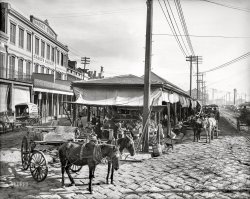
- Upstairs, Downstairs: 1907
- ... & Crescent System, which included the Cincinnati, New Orleans & Texas Pacific, so it would have been incorporated into the ... Posted by Dave - 07/29/2012 - 1:27pm -
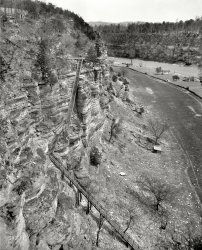
- Name That Airfield!
- ... would help identify the airport.
It could be the New Orleans Lakefront Airport Also know as the Shushan Airport. The photos I ... mine...
Amazing Eyes You (Two) Have! justhappy's New Orleans identification makes perfect sense to me. That building looks just ... Posted by Jim Page - 09/28/2012 - 8:05pm -
























